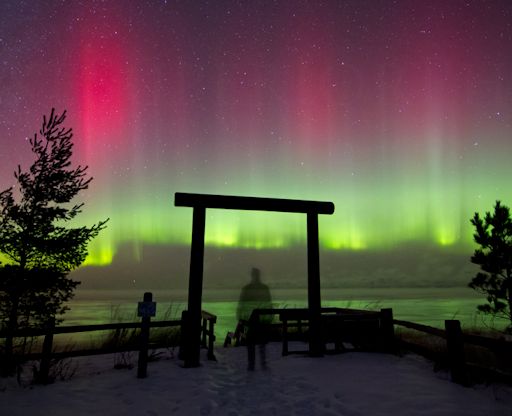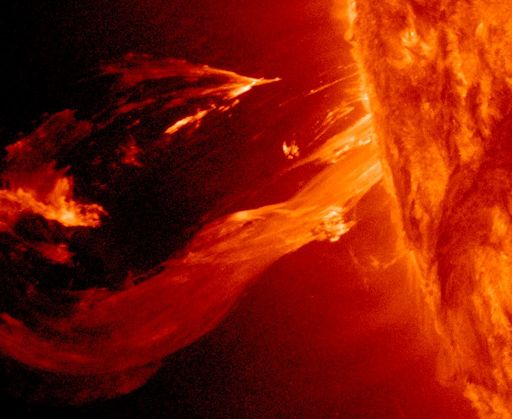When is the best time to see auroras? Where is the best place to go? And how do you photograph them? These questions and more are answered in a new book, Northern Lights - a Guide, by Pal Brekke & Fredrik Broms. | | |
HAPPY PI DAY: Today, March 14th (3.14), is  day, and all around the world pi-philes are celebrating one of the most compelling and mysterious constants of Nature. Pi appears in equations describing the orbits of planets, the colors of auroras, the structure of DNA. The value of
day, and all around the world pi-philes are celebrating one of the most compelling and mysterious constants of Nature. Pi appears in equations describing the orbits of planets, the colors of auroras, the structure of DNA. The value of  is woven into the fabric of life, the universe and ... everything.
is woven into the fabric of life, the universe and ... everything.
Humans have struggled to calculate  for thousands of years. Divide the circumference of a circle by its diameter; the ratio is
for thousands of years. Divide the circumference of a circle by its diameter; the ratio is  . Sounds simple, but the devil is in the digits. While the value of
. Sounds simple, but the devil is in the digits. While the value of  is finite (a smidgen more than 3), the decimal number is infinitely long:
is finite (a smidgen more than 3), the decimal number is infinitely long:
3.1415926535897932384626433832795
02884197169399375105820974944592307
81640628620899862803482534211706...more
Supercomputers have succeeded in calculating more than 2700 billion digits and they're still crunching. The weirdest way to compute  : throw needles at a table or frozen hot dogs on the floor. Party time.
: throw needles at a table or frozen hot dogs on the floor. Party time.
To commemorate the role of  in the physics of auroras, Shawn Malone sends this pi-riffic image from the shores of Lake Superior:
in the physics of auroras, Shawn Malone sends this pi-riffic image from the shores of Lake Superior:

"I took the picture on Dec. 8, 2013," says Malone. "The silhouette of the beach entrance reminded me of pi."
The odds of auroras on Pi Day itself are unfortunately low. NOAA forecasters estimate a scant 5% to 10% of geomagnetic storms on March 13-14. The best way to see the lights tonight: browse the gallery. Aurora alerts: text, voice
Realtime Aurora Photo Gallery
ERUPTING MAGNETIC FILAMENT: This morning, a filament of magnetism located just behind the sun's southeastern limb rose up and erupted. NASA's Solar Dynamics Observatory photographed a massive loop of plasma flying over the blast site:

For scale, the planet Neptune could slide through the loop with room to spare. Earth could fit inside more than 4 times over.
As the erupting filament flew threw the sun's atmosphere, it propelled a coronal mass ejection (CME) into space with pieces of the filament itself at its core. The Solar and Heliospheric Observatory (SOHO) tracked the CME as it raced away from the sun: movie. Earth was not in the line of fire. Solar flare alerts: text, voice
Realtime Space Weather Photo Gallery
MOTHER'S DAY AT THE EDGE OF SPACE: Looking for a unique gift for mom? How about an Edge of Space Mother's Day Card? On March 16th, the students of Earth to Sky Calculus will launch a helium balloon to the stratosphere. For only $49.95, your mother's day, father's day, birthday or anniversary card could be on the payload. Profits from the flight are used to support the students' space weather balloon research program. Contact Dr. Tony Phillips for details.
Realtime Comet Photo Gallery
Every night, a network of NASA all-sky cameras scans the skies above the United States for meteoritic fireballs. Automated software maintained by NASA's Meteoroid Environment Office calculates their orbits, velocity, penetration depth in Earth's atmosphere and many other characteristics. Daily results are presented here on Spaceweather.com.
On Mar. 14, 2014, the network reported 7 fireballs.
(7 sporadics)

In this diagram of the inner solar system, all of the fireball orbits intersect at a single point--Earth. The orbits are color-coded by velocity, from slow (red) to fast (blue). [Larger image] [movies]
Potentially Hazardous Asteroids (
PHAs) are space rocks larger than approximately 100m that can come closer to Earth than 0.05 AU. None of the known PHAs is on a collision course with our planet, although astronomers are finding
new ones all the time.
On March 14, 2014 there were potentially hazardous asteroids.
Notes: LD means "Lunar Distance." 1 LD = 384,401 km, the distance between Earth and the Moon. 1 LD also equals 0.00256 AU. MAG is the visual magnitude of the asteroid on the date of closest approach. | | The official U.S. government space weather bureau |
| | The first place to look for information about sundogs, pillars, rainbows and related phenomena. |
| | Researchers call it a "Hubble for the sun." SDO is the most advanced solar observatory ever. |
| | 3D views of the sun from NASA's Solar and Terrestrial Relations Observatory |
| | Realtime and archival images of the Sun from SOHO. |
| | from the NOAA Space Environment Center |
| | the underlying science of space weather |

